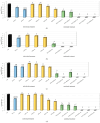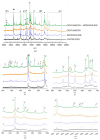Combinatory Effect of Nitroxoline and Gentamicin in the Control of Uropathogenic Enterococci Infections
- PMID: 39335003
- PMCID: PMC11428728
- DOI: 10.3390/antibiotics13090829
Combinatory Effect of Nitroxoline and Gentamicin in the Control of Uropathogenic Enterococci Infections
Abstract
Enterococcus faecalis, responsible for a majority of human and nosocomial enterococcal infections, is intrinsically resistant to aminoglycoside antibiotics (such as gentamicin, GEN), which must be used in a combined therapy to be effective. Nitroxoline (NTX) is an old antibiotic, underused for decades, but rediscovered now in an era of growing antibiotic resistance. In this in vitro study, the types of interactions between NTX and GEN on 29 E. faecalis strains were analyzed with an aim to find synergistic antimicrobial and antiadhesion combinations. Transmission electron microscopy (TEM) and matrix-assisted laser desorption/ionization time-of-flight mass spectrometry (MALDI-TOF MS) were used to analyze changes in cell morphology and bacterial proteome after monotreatments and combined treatments. The results showed the synergistic effect for six combinations on eight strains, including the ATCC29212, and an additive effect for most strains. Combinations causing a complete inhibition of adhesion were established. Cell membrane integrity was affected by NTX, while combined NTX/GEN treatment caused dramatic changes in cell morphology. Upregulation of the expression of many proteins was established, with some emerging only after combined treatment. The results strongly imply that NTX has the potential for use in combined therapy with GEN against enterococci and it could further provide a substantial contribution to an ongoing fight against antimicrobial resistance and nosocomial infections.
Keywords: E. faecalis; antiadhesion; antimicrobial resistance; enterococci; proteome; synergism.
Conflict of interest statement
The authors declare no conflicts of interest. The funders had no role in the design of the study; in the collection, analyses, or interpretation of data; in the writing of the manuscript; or in the decision to publish the results.
Figures





Similar articles
-
Emergence of High-level Gentamicin Resistance among Enterococci Clinical Isolates from Burn Patients in South-west of Iran: Vancomycin Still Working.Pol J Microbiol. 2018;67(4):401-406. doi: 10.21307/pjm-2018-043. Pol J Microbiol. 2018. PMID: 30550226 Free PMC article.
-
Identification of Enterococcus spp. from food sources by matrix-assisted laser desorption ionization-time of flight mass spectrometry and characterization of virulence factors, antibiotic resistance, and biofilm formation.Int J Food Microbiol. 2024 Aug 2;420:110768. doi: 10.1016/j.ijfoodmicro.2024.110768. Epub 2024 May 31. Int J Food Microbiol. 2024. PMID: 38843647
-
Carbonic Anhydrase Inhibition as a Target for Antibiotic Synergy in Enterococci.Microbiol Spectr. 2023 Aug 17;11(4):e0396322. doi: 10.1128/spectrum.03963-22. Epub 2023 Jun 1. Microbiol Spectr. 2023. PMID: 37260400 Free PMC article.
-
Impact on Public Health of the Spread of High-Level Resistance to Gentamicin and Vancomycin in Enterococci.Front Microbiol. 2018 Dec 18;9:3073. doi: 10.3389/fmicb.2018.03073. eCollection 2018. Front Microbiol. 2018. PMID: 30619158 Free PMC article. Review.
-
Enterococci: susceptibility patterns and therapeutic options.Eur J Clin Microbiol Infect Dis. 1995;14 Suppl 1:S33-7. Eur J Clin Microbiol Infect Dis. 1995. PMID: 7729470 Review.
Cited by
-
In vitro antimicrobial activity of nitroxoline against uropathogens isolated from China.JAC Antimicrob Resist. 2025 Feb 4;7(1):dlaf012. doi: 10.1093/jacamr/dlaf012. eCollection 2025 Feb. JAC Antimicrob Resist. 2025. PMID: 39906358 Free PMC article.
References
-
- Bereket W., Hemalatha K., Getenet B., Wondwossen T., Solomon A., Zeynudin A., Kannan S. Update on Bacterial Nosocomial Infections. Eur. Rev. Med. Pharmacol. Sci. 2012;16:1039–1044. - PubMed
-
- Toledo-Arana A., Valle J., Solano C., Arrizubieta M.J., Cucarella C., Lamata M., Amorena B., Leiva J., Penadés J.R., Lasa I. The Enterococcal Surface Protein, Esp, is Involved in Enterococcus faecalis Biofilm Formation. Appl. Environ. Microbiol. 2001;67:4538–4545. doi: 10.1128/AEM.67.10.4538-4545.2001. - DOI - PMC - PubMed
-
- Santos T., Capelo J.L., Santos H.M., Oliveira I., Marinho C., Gonçalves A., Araújo J.E., Poeta P., Igrejas G. Use of MALDI-TOF Mass Spectrometry Fingerprinting to Characterize Enterococcus spp. and Escherichia coli isolates. J. Proteomics. 2015;127:321–331. doi: 10.1016/j.jprot.2015.02.017. - DOI - PubMed
-
- Jones M.E., Draghi D.C., Thornsberry C., Karlowsky J.A., Sahm D.F., Wenzel R.P. Emerging Resistance among Bacterial Pathogens in the Intensive Care Unit-a European and North American Surveillance Study (2000–2002) Ann. Clin. Microbiol. Antimicrob. 2004;3:14. doi: 10.1186/1476-0711-3-14. - DOI - PMC - PubMed
Grants and funding
LinkOut - more resources
Full Text Sources

